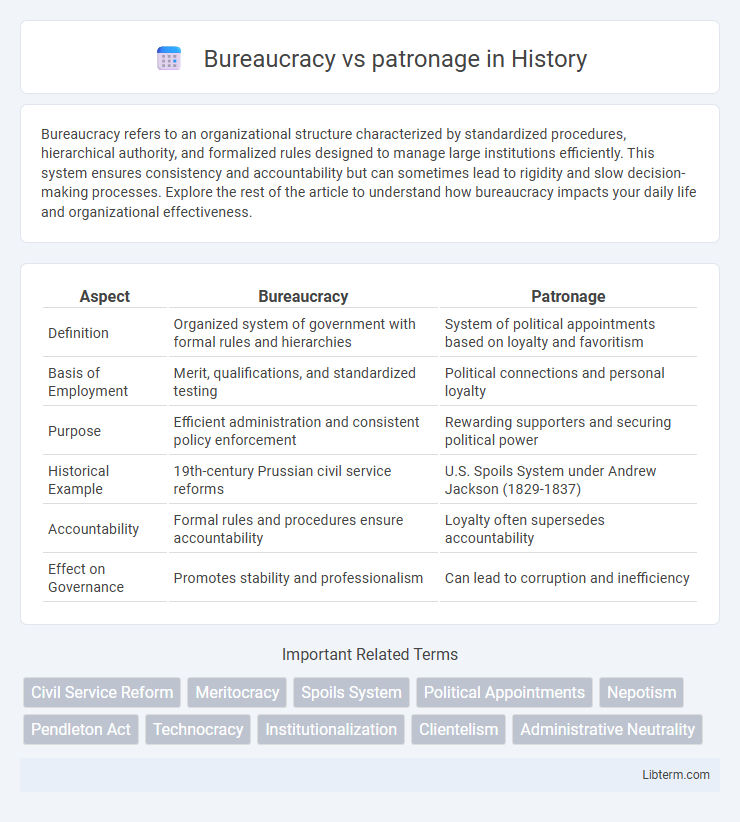Bureaucracy refers to an organizational structure characterized by standardized procedures, hierarchical authority, and formalized rules designed to manage large institutions efficiently. This system ensures consistency and accountability but can sometimes lead to rigidity and slow decision-making processes. Explore the rest of the article to understand how bureaucracy impacts your daily life and organizational effectiveness.
Table of Comparison
| Aspect | Bureaucracy | Patronage |
|---|---|---|
| Definition | Organized system of government with formal rules and hierarchies | System of political appointments based on loyalty and favoritism |
| Basis of Employment | Merit, qualifications, and standardized testing | Political connections and personal loyalty |
| Purpose | Efficient administration and consistent policy enforcement | Rewarding supporters and securing political power |
| Historical Example | 19th-century Prussian civil service reforms | U.S. Spoils System under Andrew Jackson (1829-1837) |
| Accountability | Formal rules and procedures ensure accountability | Loyalty often supersedes accountability |
| Effect on Governance | Promotes stability and professionalism | Can lead to corruption and inefficiency |
Introduction to Bureaucracy and Patronage
Bureaucracy is a structured system of administration characterized by hierarchical authority, formal rules, and specialized roles to ensure efficiency and consistency in public service delivery. Patronage, in contrast, relies on the distribution of government jobs and favors based on political loyalty rather than merit, often leading to favoritism and inefficiency. Understanding these contrasting systems highlights the ongoing balance between merit-based governance and political influence in public administration.
Defining Bureaucracy: Structure and Function
Bureaucracy is a structured administrative system characterized by hierarchical organization, formal rules, and specialized functions designed to ensure efficient and consistent policy implementation. It emphasizes merit-based appointments and standardized procedures to minimize personal bias and favoritism. Unlike patronage systems, bureaucracy relies on competence and impartiality, facilitating predictable governance and accountability within public institutions.
What Is Patronage? Meaning and Examples
Patronage refers to the practice of granting favors, jobs, or contracts to political supporters, friends, or family members rather than awarding them based on merit, which contrasts sharply with bureaucracy's structured and rule-based system. Examples of patronage include appointing loyal party members to government positions regardless of qualifications or awarding public contracts to companies connected to influential politicians. This system often leads to inefficiency and corruption, undermining transparent and professional administrative governance.
Historical Evolution: Bureaucracy vs Patronage
The historical evolution of bureaucracy began with Max Weber's model of a rational-legal authority emphasizing merit-based appointments and formal rules, contrasting sharply with patronage systems rooted in personal loyalty and political favoritism. In the 19th century, civil service reforms like the Pendleton Act in the United States marked a pivotal shift from patronage to meritocratic bureaucracies, enhancing efficiency and accountability in government. Despite these reforms, patronage persisted in many contexts, illustrating the complex interplay between institutionalized bureaucracy and political power throughout history.
Core Differences: Bureaucratic Systems vs Patronage Networks
Bureaucratic systems emphasize merit-based appointments, standardized procedures, and institutional rules designed to ensure efficiency, accountability, and impartiality in governance. Patronage networks rely on personal loyalty, political favoritism, and the allocation of resources as rewards, often leading to clientelism and weakened formal institutions. The core difference lies in bureaucracy's focus on professionalism and rule-based governance versus patronage's dependence on personal connections and political support mechanisms.
Advantages of Bureaucracy in Governance
Bureaucracy in governance ensures consistency, predictability, and impartiality through standardized procedures and clear hierarchical structures. Its merit-based recruitment and promotion systems enhance efficiency and reduce corruption by prioritizing qualifications over personal connections. This framework fosters accountability and transparency, essential for stable and fair public administration.
Benefits and Drawbacks of Patronage Systems
Patronage systems facilitate swift decision-making and strengthen political loyalty by rewarding supporters with government jobs and favors, enhancing control and resource distribution. However, this approach often leads to inefficiency, corruption, and nepotism, as appointments prioritize allegiance over merit, undermining institutional competence. Persistent patronage networks can erode public trust and hinder transparent governance, contrasting with the bureaucratic emphasis on merit-based, impartial administration.
Impact on Public Administration and Policy
Bureaucracy ensures standardized procedures and merit-based promotion, enhancing efficiency and accountability in public administration, which fosters consistent policy implementation. Patronage, by prioritizing political loyalty over qualifications, often leads to inefficiency, corruption, and policy inconsistency, undermining public trust and effective governance. The tension between these systems shapes the structural integrity and responsiveness of government institutions in delivering public services.
Modern Case Studies: Bureaucracy and Patronage in Action
Modern case studies reveal bureaucracy as a structured administrative system with merit-based recruitment aimed at efficiency and transparency, evident in countries like Singapore where civil service reforms enhance governance quality. Patronage persists in various developing nations, such as Brazil, where political appointments and resource allocations often depend on personal loyalty and networks, impacting public sector performance. These contrasting systems highlight the ongoing tension between institutional professionalism and personalized political influence in shaping governmental outcomes.
Future Trends: Balancing Efficiency and Personal Connections
Future trends in bureaucracy versus patronage emphasize leveraging digital technologies to enhance efficiency while maintaining personalized relationships through data-driven community engagement. Automation and AI streamline administrative processes, reducing red tape and decision-making delays, yet emerging platforms enable leaders to cultivate trust and tailored support within diverse constituencies. Achieving an optimal balance involves integrating transparent algorithms with human-centric governance to foster accountability without sacrificing the benefits of social capital.
Bureaucracy Infographic

 libterm.com
libterm.com